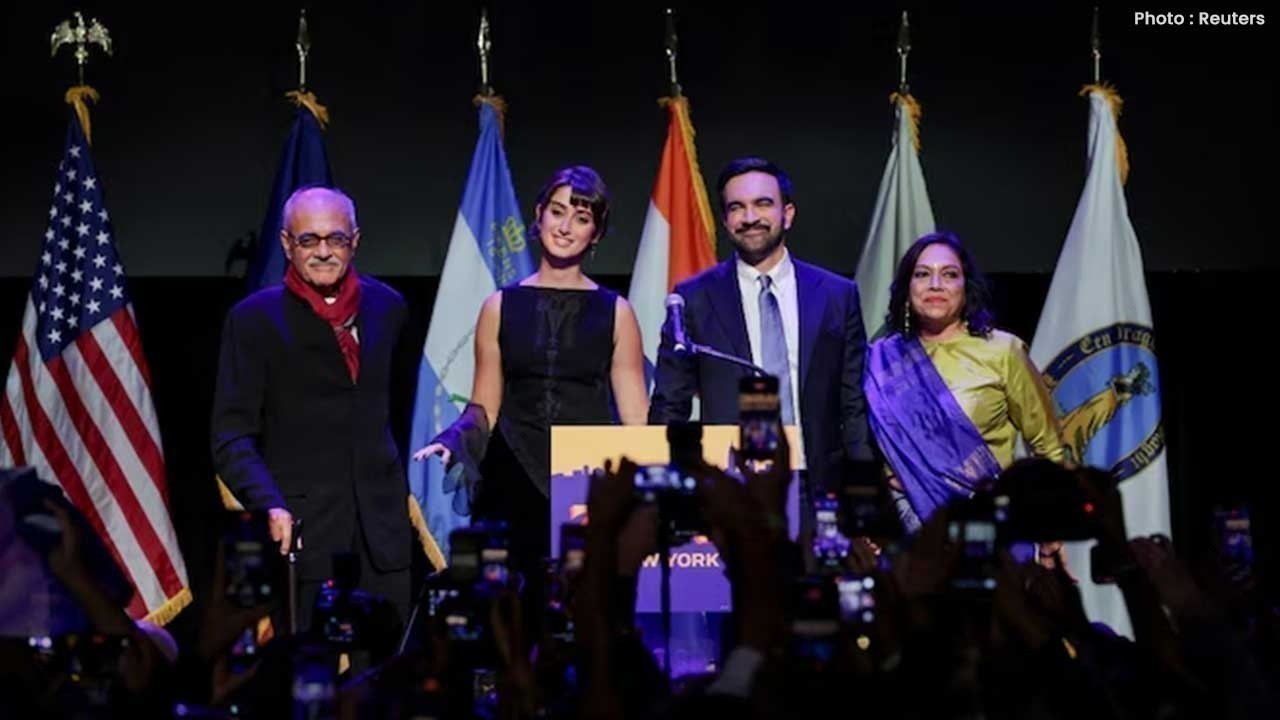
Post by : Kanchan Chandel
Al Fahidi District (Al Bastakiya)
Nestled amidst Dubai's towering skyscrapers and bustling streets lies a hidden treasure – the Al Fahidi District, also known as Al Bastakiya. This historic neighborhood, tracing its roots back to the late 19th century, offers a captivating glimpse into Dubai's rich past and serves as a poignant reminder of the city's modest origins.
In the heart of Al Fahidi District, wandering through its labyrinthine alleyways feels like embarking on a journey through time. Traditional wind-tower houses, or "barjeels," with their coral and gypsum plaster walls adorned with intricate wooden lattice-work, stand as enduring testaments to the craftsmanship of bygone eras.
More than just a historic enclave, Al Fahidi District is a vibrant tapestry of Emirati culture. Its streets are lined with art galleries, cafes, and cultural centers, each telling a unique story of Dubai's evolution. From bustling souks selling spices and textiles to serene courtyards hidden behind ancient doors, every corner resonates with history and tradition.
Despite Dubai's rapid modernization, Al Fahidi District stands as a beacon of the past. Restoration efforts have ensured the preservation of its historic buildings, maintaining the neighborhood's charm and character. The Dubai Museum, housed within the Al Fahidi Fort, offers visitors a chance to delve deeper into Dubai's rich heritage.
In recent years, Al Fahidi District has blossomed into a haven for artists and creatives. Its quiet lanes and picturesque courtyards have become backdrops for art exhibitions, workshops, and cultural events, attracting talents from around the world. From traditional calligraphy to contemporary installations, the neighborhood showcases Dubai's diverse and thriving art scene.
Beyond its historical significance, Al Fahidi District epitomizes Dubai's spirit of unity and diversity. Visitors from across the globe come together here to experience the warmth and hospitality of Emirati culture. Whether sipping Arabic coffee in a traditional majlis or exploring the vibrant souks, Al Fahidi District invites you to embrace the essence of Dubai.
As Dubai continues to evolve, Al Fahidi District remains an enduring symbol of the city's heritage and resilience. Amidst the modernity and innovation, this historic neighborhood stands as a testament to Dubai's unwavering commitment to preserving its past. Whether you're a history enthusiast, an art lover, or simply seeking an authentic experience, Al Fahidi District promises a journey through the sands of time that you won't soon forget.
Al Fahidi District, affectionately known as Al Bastakiya, whispers tales of Dubai's past, echoing the footsteps of its earliest settlers. This historic neighborhood, with its labyrinthine alleyways and traditional courtyard houses, holds the secrets of a bygone era.
The story of Al Fahidi District begins in the late 19th century when Persian merchants ventured across the Arabian Gulf to seek fortune in Dubai's burgeoning trading port. These pioneers laid the foundation of what would later become one of Dubai's most iconic neighborhoods, carving out a vibrant community amidst the desert sands.
At the heart of Al Fahidi District's historical origins lies a tapestry woven from the threads of different cultures and traditions. Persian merchants, Arab traders, and Bedouin settlers converged in this bustling enclave, exchanging goods, ideas, and stories, shaping the cultural fabric of Dubai.
The architectural landscape of Al Fahidi District is a testament to the ingenuity and craftsmanship of its early inhabitants. The district's wind-tower houses, built from coral and gypsum plaster, stand as silent sentinels, their intricate wooden lattice-work and decorative motifs reflecting the aesthetics of a bygone era.
In its heyday, Al Fahidi District was a vibrant trading hub, where merchants from across the region gathered to buy, sell, and barter their wares. The neighborhood's narrow lanes bustled with activity, as traders haggled over spices, textiles, and precious metals, weaving a tapestry of commerce that stretched from the shores of the Arabian Gulf to the distant lands beyond.
Beyond its role as a trading hub, Al Fahidi District served as a cultural crossroads where ideas and traditions intersected. It was a place where poetry was recited, music was played, and stories were shared under the starlit desert sky, fostering a sense of community and belonging among its diverse inhabitants.
As Dubai's skyline transformed and modernity swept across the city, Al Fahidi District stood as a bastion of tradition and heritage. Efforts to preserve and restore its historic buildings have ensured that future generations can continue to experience the charm and allure of this timeless neighborhood, connecting with Dubai's rich history and cultural heritage.
Certainly! Traditional architecture encompasses a myriad of styles and techniques, each tailored to its environment and cultural context. In the bustling streets of old cities like Istanbul, narrow alleyways and intricately adorned facades tell stories of centuries-old trade routes and cultural exchange. Meanwhile, in rural villages across Africa, mud-brick homes with thatched roofs stand as symbols of resilience and community spirit, built using locally sourced materials and age-old techniques passed down through generations.
One of the remarkable aspects of traditional architecture is its sustainability. Many traditional building methods prioritize local materials and natural resources, minimizing environmental impact and promoting harmony with the surrounding ecosystem. For example, adobe houses in South America and North Africa are constructed using sun-dried mud bricks, which provide excellent thermal insulation and help regulate indoor temperatures in extreme climates.
Moreover, traditional architecture often reflects the values and beliefs of the societies that produce it. In Bhutan, for instance, the design of traditional houses incorporates principles of Feng Shui and Buddhist philosophy, with intricate wood carvings and colorful paintings symbolizing prosperity and spiritual harmony.
Another fascinating aspect of traditional architecture is its adaptability to changing conditions. In regions prone to seismic activity, such as Japan and Nepal, traditional wooden buildings are designed to withstand earthquakes through flexible structural systems and interlocking joinery techniques. Similarly, in coastal areas vulnerable to flooding, stilt houses elevate living spaces above the water, ensuring resilience in the face of rising tides and storm surges.
Overall, traditional architecture offers a treasure trove of wisdom and inspiration for contemporary design and urban planning. By embracing the principles of sustainability, cultural preservation, and community engagement embedded in traditional building practices, we can create more resilient, inclusive, and environmentally friendly built environments for generations to come.
Cultural heritage is more than just a collection of artifacts and monuments; it's the living expression of a community's identity, values, and traditions. It encompasses the tangible and intangible aspects of a society's history, from ancient landmarks and archaeological sites to language, cuisine, and rituals passed down through generations.
In every corner of the world, cultural heritage serves as a bridge between the past and the present, connecting individuals to their roots and shaping their sense of belonging. It's a source of pride and inspiration, reminding us of the resilience and creativity of our ancestors in the face of adversity.
Preserving cultural heritage is not merely about safeguarding historic buildings or artifacts; it's about nurturing a sense of collective memory and shared identity. It's about recognizing the contributions of diverse cultures and communities to the tapestry of human civilization, and fostering mutual respect and understanding among people of different backgrounds.
In today's rapidly changing world, the preservation of cultural heritage faces numerous challenges, from urbanization and globalization to climate change and armed conflict. Yet, it's precisely in times of uncertainty and upheaval that the importance of cultural heritage becomes most apparent.
By safeguarding cultural heritage, we not only protect our collective past but also lay the foundation for a more inclusive and sustainable future. Cultural heritage serves as a source of inspiration and innovation, providing valuable insights into traditional knowledge and practices that can inform contemporary solutions to pressing global challenges.
Moreover, cultural heritage plays a crucial role in promoting tourism, economic development, and social cohesion. Historic sites and cultural festivals attract visitors from near and far, generating revenue for local communities and fostering cross-cultural exchange and dialogue.
Ultimately, the preservation and promotion of cultural heritage require a concerted effort from governments, communities, and individuals alike. It's a shared responsibility that transcends borders and generations, requiring us to embrace the past while embracing the future.
In celebrating cultural heritage, we celebrate the diversity and richness of human experience. We honor the achievements of our ancestors and lay the groundwork for future generations to continue the legacy of creativity, resilience, and unity that defines us as a global community.
In the heart of Dubai's historic Al Fahidi District, an artistic enclave thrives amidst the cobblestone streets and traditional wind-tower houses. This creative hub, nestled within the neighborhood's timeless charm, serves as a haven for local and international artists alike, fostering a vibrant community of creativity and expression.
Al Fahidi District's picturesque alleyways and historic architecture provide the perfect backdrop for artistic inspiration. From the intricate details of the traditional courtyard houses to the play of light and shadow in the narrow streets, every corner of the neighborhood offers a new perspective waiting to be captured on canvas or through the lens of a camera.
Within the confines of Al Fahidi District, creativity knows no bounds. Here, artists from diverse backgrounds and disciplines come together to showcase their talents and share their unique perspectives with the world. From painters and sculptors to photographers and mixed-media artists, the neighborhood buzzes with creative energy, with each artist contributing to the rich tapestry of artistic expression.
Al Fahidi District serves as a melting pot of cultures and ideas, where artists from different parts of the world converge to exchange knowledge, collaborate on projects, and push the boundaries of their craft. Through workshops, exhibitions, and collaborative events, the neighborhood fosters a spirit of camaraderie and mutual support, enriching the artistic community and nurturing the next generation of talent.
Beyond its aesthetic appeal, the artistic enclave in Al Fahidi District plays a vital role in engaging the local community and fostering a sense of pride and ownership in the neighborhood's cultural heritage. Through public art installations, community projects, and outreach programs, artists collaborate with residents to celebrate the district's history and traditions, bridging the gap between past and present.
Artists in Al Fahidi District are not just creators; they are also custodians of the neighborhood's cultural heritage. Through their work, they pay homage to the rich history and architectural legacy of the district, ensuring that its stories and traditions are preserved for future generations. Whether through mural paintings that depict scenes from Dubai's past or sculptural installations that celebrate its maritime heritage, artists play a vital role in keeping the spirit of Al Fahidi alive.
In the labyrinthine lanes of Al Fahidi District, efforts to preserve its historic charm are a labor of love intertwined with Dubai's narrative of progress. Amidst the clamor of modernity, whispers of heritage echo through the coral walls and wind towers, reminding us of the importance of safeguarding our past.
Preservation in Al Fahidi is not merely about maintaining old buildings; it's a delicate dance between tradition and progress, a testament to Dubai's commitment to honoring its roots while embracing the future. The Dubai Municipality, along with local heritage organizations, has embarked on a journey to restore and conserve the district's architectural treasures, breathing new life into age-old structures.
Walking through Al Fahidi, one can't help but marvel at the meticulous restoration work that has revived the neighborhood's historic buildings. From intricate wooden lattice-work to ornate doorways adorned with traditional motifs, every detail is a nod to the craftsmanship of yesteryears.
But preservation goes beyond bricks and mortar; it's about fostering a sense of community and pride in our shared heritage. Local residents, artisans, and historians come together to celebrate Al Fahidi's rich history through cultural events, workshops, and storytelling sessions, keeping its traditions alive for future generations.
The conservation efforts in Al Fahidi District serve as a beacon of inspiration for other historic neighborhoods across Dubai and beyond. They remind us that while progress is inevitable, our past is irreplaceable, and it's our duty to safeguard it for posterity.
As visitors stroll through the narrow alleyways of Al Fahidi, they're not just witnessing history; they're part of a timeless narrative that continues to unfold with each passing day. In preserving Al Fahidi, Dubai honors its past, celebrates its present, and paves the way for a more vibrant and culturally rich future.
Nestled within the vibrant streets of Dubai lies a treasure trove of history and culture – the enchanting Al Fahidi District, a tourist destination like no other. As you step into this atmospheric neighborhood, you're transported back in time to the days of old Dubai, where tales of traders, fishermen, and craftsmen unfold at every corner.
Walking through the narrow alleyways of Al Fahidi District feels like entering a time capsule. The architecture here is a testament to Dubai's rich heritage, with traditional wind-tower houses adorned with intricate wooden latticework and cooling water channels. It's a glimpse into the lives of the early residents who called this neighborhood home.
Al Fahidi District isn't just about buildings; it's a living, breathing museum of Emirati culture. Step into the Dubai Museum housed within the Al Fahidi Fort, and you'll uncover artifacts and exhibits that tell the story of Dubai's evolution from a humble fishing village to a global metropolis. Explore the exhibits on pearl diving, traditional trades, and Bedouin life, and you'll gain a deeper understanding of the city's roots.
In recent years, Al Fahidi District has become a hub for artistic expression. Wander through its labyrinthine streets, and you'll stumble upon art galleries showcasing the works of local and international artists. From contemporary paintings to traditional crafts, there's something here to pique every art lover's interest.
Despite Dubai's rapid development, Al Fahidi District has managed to retain its old-world charm. Thanks to ongoing preservation efforts, the neighborhood's historic buildings have been restored to their former glory. Today, you'll find boutique hotels, cafes, and cultural centers nestled amidst the traditional architecture, offering visitors a taste of authentic Emirati hospitality.
Visiting Al Fahidi District isn't just about sightseeing – it's an immersive experience that engages all your senses. Sip on traditional Arabic coffee at a local cafe, haggle for souvenirs at the bustling markets, or simply stroll through the streets and soak in the ambiance. Whether you're a history buff, an art enthusiast, or simply a curious traveler, Al Fahidi District has something to offer everyone.
Al Fahidi District, also known as Al Bastakiya, is a historic neighborhood nestled amidst Dubai's modern skyline. Dating back to the late 19th century, this enchanting enclave offers visitors a glimpse into Dubai's rich past through its traditional wind-tower houses, bustling souks, and cultural attractions. From exploring the Dubai Museum housed within the Al Fahidi Fort to discovering art galleries and cafes tucked away in its labyrinthine streets, Al Fahidi District promises a unique and immersive experience for travelers seeking to delve into the city's heritage.
The views and opinions expressed in this article are those of the author and do not necessarily reflect the official policy or position of DXB News Network. Readers are encouraged to conduct further research and consult relevant sources before making travel plans or forming opinions based on the information provided. DXB News Network does not endorse any specific attractions, businesses, or services mentioned in this article.

Manika Vishwakarma Stuns in Brown Anarkali at Miss Universe 2025
Miss Universe India 2025 Manika Vishwakarma dazzles in a brown anarkali with intricate embroidery, g

UN Adopts Resolution 2799, Lifts Sanctions on Syrian Leaders
UN Security Council passes Resolution 2799, lifting sanctions on Syria’s President Ahmed al-Sharaa a

Radhika Merchant Shines in Mint-Green Minimalist Suit Look
Radhika Merchant stuns in a minimal mint-green suit, pairing subtle embroidery with classic accessor

North Korea Fires Ballistic Missile Amid Trump’s Call for Talks
North Korea fired a ballistic missile amid Donald Trump’s renewed call for talks with Kim Jong Un, e

Trump Calls Modi ‘A Great Man,’ Hints at India Visit in 2026
Trump praises PM Modi, says trade talks with India going strong and hints at a possible visit to Ind

Supreme Court Orders Stray Dogs Cattle Removal Nationwide
Supreme Court orders all states to remove stray dogs and cattle from public spaces, highways, and sh

Forensic Tests Confirm Teen Behind Mexican Mayor Carlos Manzo’s Murder
Forensic tests confirm 17-year-old Victor Manuel Ubaldo as the gunman in Mexican Mayor Carlos Manzo’

The New Season Alert Maharani Season 4 Coming Soon
Maharani Season 4 arrives on SonyLIV with Huma Qureshi as Rani Bharti facing new rivals bold politic

Paramount+ to Stream PBR’s Top Bull Riding Series in 2025
Paramount+ secures 5-year rights for PBR's "Unleash the Beast," streaming live across 17 states from

Zohran Mamdani Victory Speech Goes Bollywood with Dhoom Machale
Zohran Mamdani wins NYC mayor race, becoming the city’s first Muslim and South Asian mayor, making h

UAE Life High Stress 3 Simple Ways Expats Can Manage Pressure
Expats in the UAE face daily pressure and burnout Learn 3 simple effective ways to manage stress fin

Smart Meal Prep in Dubai Save Money Stay Healthy
Plan smart eat fresh Discover how meal prepping in Dubai helps you save money eat healthy and enjoy

The Ultimate Guide to Dieting in Dubai Keto vs Vegan vs Mediterranean
Discover Dubai’s top diet trends Keto Vegan and Mediterranean Find which plan fits your lifestyle f

Stay Fit in Dubai 7 Fun Outdoor Workouts Without a Gym
Explore 7 fun ways to stay fit in Dubai from beach runs to desert hikes and skyline yoga No gym nee

Beyond Biryani: Mastering Portion Control in Dubai’s Melting Pot of Cuisines
Discover how to enjoy Dubai’s diverse cuisines wisely Learn simple portion control tips to stay heal